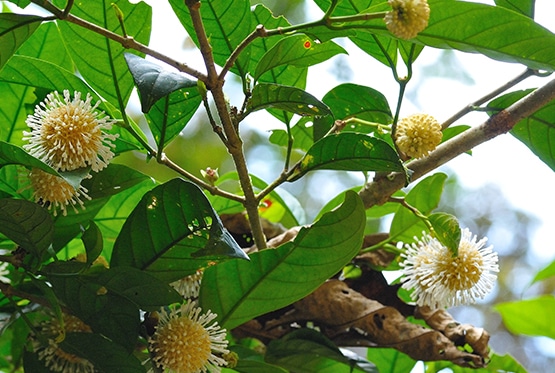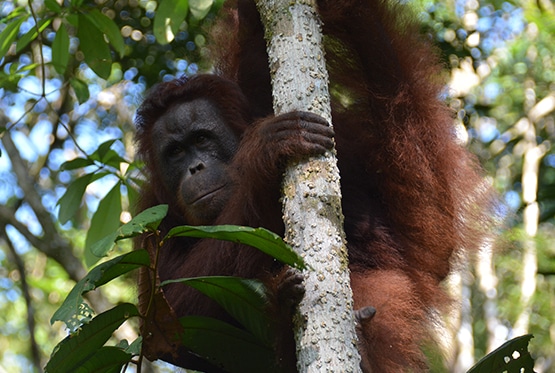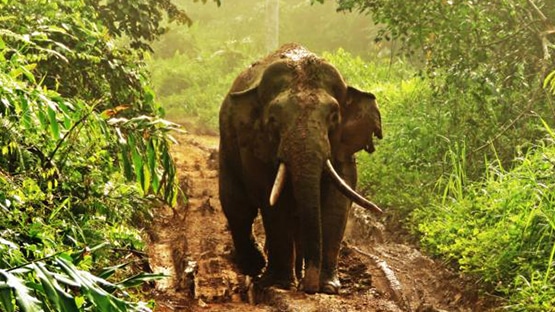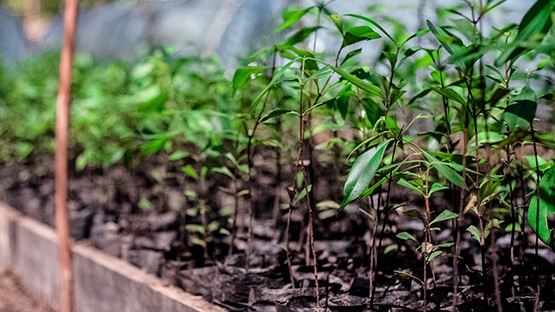Biodiversity conservation
The world is currently experiencing the greatest extinction of species since the disappearance of the dinosaurs. The consequences are dramatic not only for the flora and the fauna, but also for us humans. The loss of biodiversity is destabilising our ecosystem, accelerating climate change, and driving the spread of diseases. We are experiencing it firsthand right now. But one thing is certain: preserving the diversity of the world’s animals and plants and protecting their habitats is a century-long task that we can only accomplish together.
The orangutan as an umbrella species
You are currently viewing a placeholder content from YouTube. To access the actual content, click the button below. Please note that doing so will share data with third-party providers.
More InformationClimate change, deforestation of rainforests, and the relentless global population growth have taken a toll on our closest animal relatives—the great apes, including orangutans, chimpanzees, bonobos, and gorillas. Their habitats have dramatically shrunk in the past two decades, leading to a dire decline in their populations. Compounding this issue is the rampant illegal wildlife trade, which victimizes millions of protected animals worldwide each year. The survival of these great apes hangs in the balance.

Diverse vegetation in the rainforest

Wild female orangutan in the rainforest
Species conservation should be a paramount concern on both political and social agendas. Safeguarding biodiversity is an enormous undertaking, and BOS is actively engaged in two distinct projects aimed at ensuring the sustainable protection of Borneo’s rich biodiversity.
The sound of the rainforest
Reforestation projects

Wildlife corridor
In Sabah, Borneo, rainforests have been destroyed for palm oil plantations, putting wildlife like banteng, pygmy elephants, orangutans and many rare birds species in grave danger. We are creating a wildlife corridor to allow these animals to freely move between two protected areas.

The peatlandforest of Mawas
The peat swamp area of Mawas in the Indonesian part of Borneo was once the home of wild orangutans and hundreds of other animal species. Then, it was partially destroyed in the 90es by the so a big agricultural project. Now, we are creating new rainforest here, giving the orangutans their home back.
A Lifeline for Wildlife: Creating a Corridor
We are transforming plantations back into rainforests.
The habitat of the orangutan and many other rare species is dying, and with it, these unique creatures. Every day, vast areas of rainforest are destroyed for oil palm cultivation. In Sabah, Borneo, we are now reversing this trend. We purchase palm oil plantations and convert them back into thriving rainforests.
Frequently asked questions
What is meant by species conservation?
Your Subtitle Goes Here
Species conservation means preserving the world’s biodiversity of animals and plants and conserving their habitats. All of this requires concrete measures at the sub-national, national, regional and local levels, which are usually regulated by laws, regulations, guidelines and agreements. The measures are enforced by corresponding organisations and initiatives.
Which animals are most threatened with extinction?
Your Subtitle Goes Here
The global environmental organisation IUCN (International Union for Conservation of Nature) regularly publishes the “Red List” of animal and plant species threatened with extinction worldwide. The list serves as a guide for actions regarding the protection of species, nature and the environment worldwide. The IUCN currently estimates that more than 37,400 species are threatened with extinction. Amphibians top the list at 41 percent, with mammals second at 26 percent. Sunce 2016 the Bornean orangutan has been classified as a critically endangered species.
What does it mean when an animal is classified as a protected species?
Your Subtitle Goes Here
If an animal is protected as a species, it is illegal to hunt or capture it.
What threatens species conservation in Indonesia?
Your Subtitle Goes Here
The destruction, fragmentation, and loss of natural habitats have immediate effects on species diversity: flora and fauna in tropical forests are disappearing, habitats are shrinking, and there is a lack of refuge for animals. Furthermore, human-induced climate change is accelerating the pace of natural climate change to an alarming degree. Many species are overwhelmed by the changes in ecosystems and cannot adapt quickly enough.
In a direct and cruel manner, the wildlife trade also contributes to the disappearance of species: the smuggling of wild animals is a billion-dollar industry. Exotic animals are kept as pets, consumed as food, or processed for medicine. This illegal trade not only contributes to species extinction but also poses a significant threat to humans, as we have experienced firsthand through the COVID-19 pandemic. All of this represents an immense threat to biodiversity.
How can we protect the genetic diversity of species?
Your Subtitle Goes Here
Every year, well over a million hectares of rainforest are destroyed in Borneo, mainly in order to cultivate oil palms. The resulting monocultures are reducing biodiversity to an alarming extent: they endanger animal species living here, such as orangutans, pygmy elephants or bantengs, as in addition to reducing the food supply they also fragment formerly connected habitats. For many animals, crossing plantations in search of food and getting too close to humans ends in their death. Yet, primarily the problem is a long-term one: as a result of habitat fragmentation, animals remain only in their original group, causing the gene pool to continuously shrink. This is one of the main reasons for species extinction. After all, higher biodiversity produces more robust species that can better adapt to the effects of climate change or diseases. Therefore, in addition to protecting remaining natural landscapes and their wildlife populations, the connectivity of habitats in particular is a key measure for preserving biodiversity.
What is the difference between species protection and nature conservation?
Your Subtitle Goes Here
Species conservation is a part of nature conservation and is concerned with the protection of habitats in addition to the protection of individual species. Species conservation aims to preserve the species. Nature conservation focuses on the ecosystem as a whole.